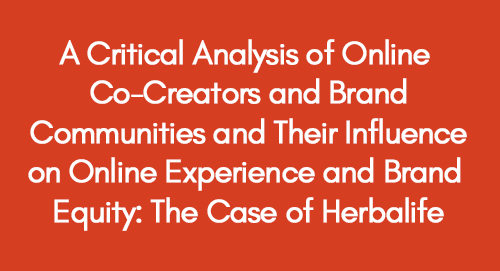
Tourism and Hospitality
July 12, 2022
A Critical Analysis of Online Co-Creators and Brand Communities and Their Influence on Online Experience and Brand Equity: The Case of Herbalife
July 12, 2022In the kaleidoscope of self-expression, fashion stitches together the vibrant hues of individuality, weaving a tapestry that narrates stories without uttering a single word.
Outline
- Conventional Fashion Brand Development
- The Emergence of Influencers’ Fashion Brand
- Social Media
- Social Media Influencer Competences
- Conclusion
In a society where self-expression is paramount, fashion emerges as the silent yet eloquent language that communicates volumes without needing words. As a dynamic and constantly evolving art form, it surpasses boundaries, transcends cultures, and stands resilient against the relentless march of time. Our exploration invites you to embark on a captivating journey through the multifaceted world of fashion, where we unravel the intricate threads that intricately weave together the realms of style, identity, and innovation.
Step into a realm where garments become the brushstrokes on the canvas of individuality, each ensemble painting a unique portrait of the wearer. This vibrant tapestry of fashion not only reflects personal tastes but also mirrors societal shifts and cultural nuances. Together, let's delve into the profound interplay of fabric and design, discovering how these elements contribute to the rich and ever-expanding narrative of self-expression that defines the language of fashion.
Conventional Fashion Brand Development
Conventional fashion brand development involves a strategic and sequential process to establish, grow, and sustain a brand's presence in the market. It typically begins with meticulous market research to identify target demographics and assess consumer needs. Following this, the brand defines its unique identity, encompassing values, aesthetics, and messaging. Designing and producing collections that align with this identity is central to building brand recognition and loyalty. Effective marketing campaigns, retail partnerships, and a strong online presence enhance the brand's visibility and market positioning. Conventional fashion brand development requires a harmonious blend of creativity, business acumen, and a deep understanding of consumer trends to carve a lasting niche in the competitive fashion landscape.
Structural Management
Traditional fashion brands recognize the significance of structured management in effectively planning their production processes. According to Kapferer (2008), a brand's inception revolves around tangible or intangible assets embedded in its products or services. Historical trends reveal that brands often emerge from innovation, focusing on creating products or services that yield profits. Notable examples include Nike and Adidas, which are celebrated for their innovative sports categories as tangible assets. Whether tangible or intangible, the overarching aim for brands is to present offerings that resonate with consumer desires. Given the dynamic nature of the fashion landscape and its continuous evolution to meet consumer preferences, brands must prioritize competitiveness and sustain market growth by enhancing their structural planning, processes, and technologies (Varley et al., 2018).
Moreover, as highlighted by Jackson (2012), the fashion industry functions as a business entity involved in the design, production, sale, and promotion of clothing. This underscores its commercial purpose within the conventional brand business. Essentially, practical operations are geared towards creating fashion garments tailored for established selling seasons, a strategy that fosters long-term income generation (Kompella, 2015; Varley et al., 2018). The essence lies in the strategic and operational fusion that propels traditional fashion brands to navigate the ever-shifting currents of consumer preferences and industry trends.
Strategy for Product Development
According to Low and Fullerton (1994), successful brand management history involves a comprehensive macro-level environmental analysis as a foundational step. Brands embarking on this journey meticulously plan strategies to grasp a profound understanding of the external landscape. Particularly in product development, certain brands derive design inspiration by modifying existing designs or keeping a pulse on the latest trend forecasts in the conventional design process (Dissanayake & Sinha, 2015). Considering the intrinsic value of 'change' in the fashion landscape, fashion ranges are meticulously crafted to be consistent "on-trend," encompassing elements such as colour, print, silhouette, and styling details (Jackson, 2012). Take Zara, for example, where designers stay acutely attuned to a spectrum of trend information, including textile and garment fashion shows, specialized trend forecasts, and even social media insights like Instagram influencer trends. This proactive approach is essential for remaining at the forefront of the dynamic fashion industry (Hanbury, 2018).
Brand Identity
The interplay between a brand and its customers can be conceptualized as an intangible bond (refer to the figure). Varley et al. (2018) highlight that a brand's potency results from functional performance and emotional significance. Central to constructing a brand strategy is establishing brand identity, representing customers' desired perception (Aaker & Joachimshaler, 2000; Grime et al., 2002). This concept holds immense value in strategically positioning a brand and fostering differentiation within the competitive landscape of the fashion market. The framework of a brand identity system, illustrated in the figure, encapsulates the core of brand identity. Furthermore, brand identity is a potent and strategic endorsement of qualities like quality, value, and reliability (Varley et al., 2018). Given the information overload and messaging saturation on social media, customers tend to gravitate towards brands that offer a sense of self-concept and symbolic elements. Consequently, brand identity not only functions as a communication tool to effectively target customers but also as a means to establish and sustain a meaningful connection with them.

Brand Image / Personality
Consumers' perception of a brand, known as brand image, is shaped by their knowledge and experiences with the brand (Varley et al., 2018). This image, heavily influenced by social media and its diverse array of information, consumer interactions, and word-of-mouth, is a powerful force (Schultz and De Chernatony, 2002). Functioning as a brand's personality, it reflects the subjective and perceptual opinions formed by customers' memories. The structural planning process, integral to imbuing meaning into product sales, intertwines brand images and language (Kompella, 2015; Kapferer, 2008). Consequently, associating branded garments with a positive brand image can cultivate a non-traditional emotional shopping experience, fostering a favourable attitude and customer loyalty (Kompella, 2015; Aaker, 1996).
Brand Authenticity
According to Kapferer (2008), a brand must exude certainty and trust, particularly in today's postmodern market, characterized by extensive choices and a lack of transparency in customers' purchasing experiences, leading to excessive consumption (Oh et al., 2019). Brand development is intricately linked to authenticity, as Vandepas (2003) emphasizes its role as a holistic approach to nurturing customer relationships. Brand authenticity significantly influences strategic decisions, with Napoli et al. (2014) and Hernandez-Fernandez (2019) highlighting its integral role as a cornerstone for achieving financial growth in internal and external brand plans.
In an era where customers face challenges in determining the right product amid an abundance of choices, the essence of authenticity holds paramount importance. Building trust through brand authenticity requires time and a willingness to take risks, as suggested by Kapferer (2008). Various drivers, including economic factors (price), functional aspects (product performance), and psychological elements (customer preferences derived from brand images), can impact authenticity, thereby influencing customer perceptions and consumption patterns.
Choi et al.'s (2014) study identifies seven factors constituting fashion brand authenticity: authority, fashionability, consistency, innovativeness, sustainability, origin, and heritage. Brand authenticity extends beyond the product itself, encompassing a multidimensional construction. Research indicates that perceived brand authenticity in fashion brands is influenced by indexical cues, which involve objective facts of customers' experiences and perceptions, iconic cues stemming from subjective impressions such as advertising, and existential cues that encompass self-referential characteristics (Carsana & Jolibert, 2018; Choi et al., 2014; Mohart et al., 2014).
The Emergence of Influencers’ Fashion Brand
In contemporary times, consumers are increasingly pursuing deeper meaning in their lifestyles, workplaces, and consumption habits (JWT Intelligence, 2018). This trend has paved the way for emerging brands, particularly those embodying the essence of influencer fashion.
Influencer Personality (Self-Presentation)
Unlike conventional brands that construct a framework for brand identity to persuade their customers, influencers naturally possess unique qualities and cultivate a distinct public image to captivate audiences. Influencer brands can be regarded as "commercially branded products," leveraging their distinctive selling points to cater to the needs and interests of their target audience (Khamis et al., 2016). The messages conveyed by influencers are deemed as "one of the few forms of real and authentic communication," enabling them to carve out a distinct and unique personal brand identity (Scott, 2015, p.295). This phenomenon is recognized as an emerging brand that affirms true identity (Blanco, 2010, p.1).
To curate their self-presentation for their audiences, influencers employ various techniques on social media platforms. This includes sharing original and creative content, posting photos, creating videos that provide insights into their lives, and fostering direct communication with their followers (Duffy & Wissinger, 2017; Marwick, 2013; Suhr, 2014).
Influencer Authenticity
The surge in authentic consumption is attributed to a perceived lack of meaning and self-identity in traditional brand sources (Mohart et al., 2014). As contemporary society navigates the shift towards the informational and knowledge era, influencers have embraced their role by embodying the fundamental principles and foundations of 'intangible brand value' (Blanco, 2010, p.1). In essence, the authenticity conveyed by influencers can be viewed as a psychological framework and mechanism that serves as a wellspring of inspiration and emotional connection for customers. The perceived closeness that influencers cultivate is intricately linked to brand-building success. Audrezet et al. (2018) underscore the significance of passion and transparent authenticity as pivotal elements in establishing meaningful connections with audiences.
Similarly, the engagement strategies employed by influencers, as highlighted by Khamis et al. (2016) and Abidin (2015), convey a genuine interaction, creating an impression of an exclusive and intimate exchange. This nuanced approach is crucial in fulfilling the promise of authenticity, setting the stage for a distinctive brand development compared to conventional counterparts.
Social Media
Social media, a transformative force in the digital landscape, has redefined how individuals connect, share, and engage with information. Social media facilitates real-time communication through platforms like Facebook, Instagram, Twitter, and more, fostering global conversations and transcending geographical boundaries. It is a dynamic stage for personal expression, enabling users to showcase their creativity, opinions, and experiences. Moreover, social media is pivotal in shaping public discourse, influencing trends, and empowering diverse communities. Its impact extends across industries, from business and marketing to politics and culture, making social media an integral and ever-evolving aspect of contemporary life.
Definition of Social Media and Individuals’ Behavior on Social Media
The surge of social media has profoundly shaped society, ushering in diverse online social interactions. Social media is a fusion of ideological and technological platforms, acting as a virtual space where users create communities to exchange information, ideas, personal messages, and content (Hsu & Lin, 2017; Wang et al., 2016). Research on social media usage can be categorized into two perspectives: the uses and gratification theory (U&G) and perceived interactivity (Hsu et al., 2015). Drawing on the U&G framework proposed by Katz et al. (1973), this study integrates psychological processes to comprehensively assess how Taiwanese customers derive gratification through social media by fulfilling specific motivations. Social media usage motivations encompass information seeking, entertainment, socialization, and self-presentation. InSite Consulting's survey (2019) echoes this, revealing that individuals primarily engage in social media for information search (40%), entertainment (39%), and social interaction (33%). Recognizing social media as a means for individuals to satisfy social and psychological needs (Katz et al., 1973), it becomes crucial to delve into the gratification process and explore how Taiwanese customers' behaviour aligns with social media usage.
Social Identity
Social media is a platform that provides opportunities for individuals to fulfil interpersonal and interactive goals (Barker, 2009). Pan et al. (2017) state that social identity could capture the interactive nature of social media, which facilitates relationship building. People could identify their belonging to the community through interaction with others and further support by specific group identification. There is a correlation between social identity and self-image. Social identity can influence individuals’ intention to belong in a virtual community and improve their self-image (Song &Kim, 2006; Fotiadis & Stylos, 2016). Before participating in a particular social relationship, individuals utilize social media to share their information on the platform. This self-expression behaviour is aligned with a motivation of self-verification to confirm an established self-concept and maintain consistency in self-knowledge ( Fotiadis & Stylos, 2016; Escalas & Bettman, 2003). To be defined as a social identity, individuals need to express themselves on social media and obtain others’ acceptance (Shao, 2009). Thus, the importance of the social identity perspective is appropriate for explaining individuals’ behaviour on social media.
Social Relationship & Virtual Community
Individuals perceive social needs as the strongest force to use social media (Wang et al., 2012; Hsu & Lin, 2017). Previous research demonstrates that social relations could be affected by two potential factors: information acquisition and sharing and reputation building. The action of acquisition and sharing allows users to exchange social support and maintain existing or new relationships. Through the relationship, users can also interact with others by sharing the content and photos online directly, thus enhancing connectedness (Zhao & Rosson, 2009). Regarding the importance of information acquisition and sharing, it is acknowledged as one of the main motives for using social media since the actions could influence virtual community development (Hersberger et al., 2007). As for reputation building, social exchange is the foundation of gaining a reputation. Individuals seek rewards from others while they provide in the same way to others (Hsu & Lin, 2017). Indeed, the process of exchanging comprises tangible and intangible benefits. Intangible rewards could be recognized as psychological needs, such as recognition, respect, or peer approval. In addition, research shows that people who contribute information will likely be placed a higher reputation in a “virtual community”, and it will be defined in more detail below (Oreg & Nov 2008). Meanwhile, Chi (2011) examines 502 Taiwanese social media users, revealing that they considered virtual communities trustworthy and entertaining to satisfy their social needs. Therefore, it could be believed that users would focus on creation and reputation building to maintain social relationships.
The world of social networks has the power to gather virtual communities. The virtual community is a group of like-minded individuals who link customers with a passion for similar activities, products, and even influencers (Hamilton & Hewer, 2010; Juhlin &Soini, 2018). Social media provides individuals with an environment to gather for sharing, conversation, and interaction; this, indeed, provides the opportunity for influencers to form unquenchable social appetites and thirsts of individuals for community affiliation and differences. Meanwhile, Hamilton & Hewer (2010) argue that customers’ consumption could largely depend on the factor of a virtual community because it is highly involved in emotion and often appears with individuals’ self-concept. In particular, the emotional alliances with influencers could make meaning of an individual’s social identity and social relationships with individuals who could create authentic relationships. Hence, it is essential to understand the insight of virtual communities contributing to the effective relationship between customers and social media influencers and how influencers effectively use the community to maintain the popularity of their fashion labels.
Social Media Use in Taiwan
Taiwan has an established network infrastructure that encourages the high popularity of internet usage and e-commerce performance (TWNIC, 2018). This result brings the internet and individuals’ lives to be interconnected. The annual digital growth in active social media users increased by 11%, and 21 million spend an average daily of 1H52M using social media (WeAreSocial, 2018). According to the survey from TWNIC (2018), “content media” and “social media” are the top reasons for Taiwanese internet usage, 88.5% and 80.6%, respectively. And three platforms, Facebook, Instagram, and YouTube, are the most visited. Compared to other Asian countries, Taiwan performs in third place, with 76% of Taiwanese browsing social media. Thus, it has gradually transformed people’s lifestyles and habits.
In the case of the use of social media, TWNIC (2018) investigates that it has approached 80.6% of total social media usage, which is 80.1% of male users and 81.1% of female users. Also, the observation shows that the age groups between 15-19 and 20-24 years old share similar results of 97.0% and 97.9%, respectively. As it can be recognised, the 20-24-year-old population actively browses social media. And 94.7% of users search on Facebook, and 71.0% use Instagram. Interestingly, females are highly involved in social media in each age group 99.2%.
Since previous paragraphs discuss how social media leverage individuals’ usage perspective and gratifications, the research indicates the reasons for user behaviour. By the highest rate of 72.2% of users, they browse social media to follow others' posts, photos and videos. Around 40 % of others share their mood and update the current situation on social media platforms to communicate and be connected with their friends and followers. Hence, it can be acknowledged that Taiwanese active social media users use social media to socialize and seek psychological needs.
Social Media Influencer Definition
The social media influencer (SMI) concept is a new independent third-party endorser who can form individuals' attitudes and perspectives through social media platforms like Facebook, Instagram, or Twitter (Freberg et al., 2011). Similarly, both Abidin (2015) and Enke & Borchers (2019) define influencers as active and ordinary internet users who accumulate a relatively large following on social media platforms through the textual and visual narration of their living and lifestyles. Also, by engaging with their audiences in digital spaces, influencers have had to monetize their impact power, such as posts and stories, to make further commercial activities. Hence, to demonstrate influencers’ position in the value creation process and further deliver an effective impact to their fashion labels, it will identify four elements of influencers’ competencies regarding their productive relationship inputs.
Social Media Influencer Competences
Social media influencers wield distinct competencies that propel them into the spotlight of online prominence. Beyond having a substantial following, these influencers demonstrate a knack for content creation, displaying creativity and originality that resonate with their audience. Proficiency in understanding and navigating various social media platforms is a key competence, allowing them to tailor content to specific channels effectively. Influencers also excel in community building, fostering engagement, and crafting an authentic online persona. Adaptability to evolving trends and strategic collaboration skills further solidify their competence in staying relevant and influential in the dynamic landscape of social media. Ultimately, the harmonious blend of relatability, expertise, and a finger on the pulse of digital culture distinguishes social media influencers and cements their competencies in the ever-expanding realm of online influence.
Content Distribution
SMEs are known for their ability to draw audiences’ attention through their content on social media (Enke &Borchers, 2019). They acquire the ability to produce successful content on social media to gain interest from their audiences; hence, SMIs emerge from the dynamic of a multitude of communities and the public that have developed a good understanding of the online platform environment (Arvidsson et al., 2016). For instance, SMIs strategically apply hashtags and mentions to link back to their posts on specific discourses or users; they also carefully choose the right titles to attract attention on the scheduled timetable.
Interaction
The characteristic of social media is that it allows two-way communication and dialogue, which becomes a useful tool for SMEs to interact with their audiences. SMI acquires the competencies to initiate, encourage, and direct interactions on platforms that could further enhance the quality of a specific audience relationship (Solis & Breakenridge, 2009; Enke &Borchers, 2019). For example, SMIs will invite their audiences to comment and share experiences with them and might discuss topics for a closer understanding. These actions are essential to SMIs since they signal accessibility and authenticity for a peer status, which can contribute to establishing a value position in audiences’ perspectives.
Public Persona
The concept of public persona has been highlighted, and this creation is based on self-branding techniques and could be consumed by social media users (Markwick, 2015; Hearn & Schoenhoff, 2015). Meanwhile, Hearn & Schoenhoff (2015) argue that how SMIs cultivate attention and craft an authentic ‘personal brand’ through social media could be captured as the concept of personal brand capital.
Relationships Quality
SMI and their audience's relationship could be described in three types: peer-to-peer relations, egalitarian friendships or a sense of equality (Jerslev, 2016; García-Rapp, 2017). The peer status implies a similarity between SMI and their followers in their structural situatedness. For instance, fashion influencers and their audiences might face comparable issues when finding the right outfit for their appearances. Moreover, García-Rapp (2017) shows that YouTuber Bubz discloses her daily activities and information to deepen the affective connections. This relationship could heavily draw on intimacy and support the perceived peer-to-peer qualities between SMI-audience relationships.
Conclusion
In conclusion, the trajectory of fashion brand development intertwines tradition and innovation, strategy and spontaneity, authenticity and relatability. As the fashion landscape evolves, brands find themselves at the crossroads of convention and disruption, seeking to create meaningful connections in a world where the only constant is change.
Get 3+ Free Dissertation Topics within 24 hours?



























